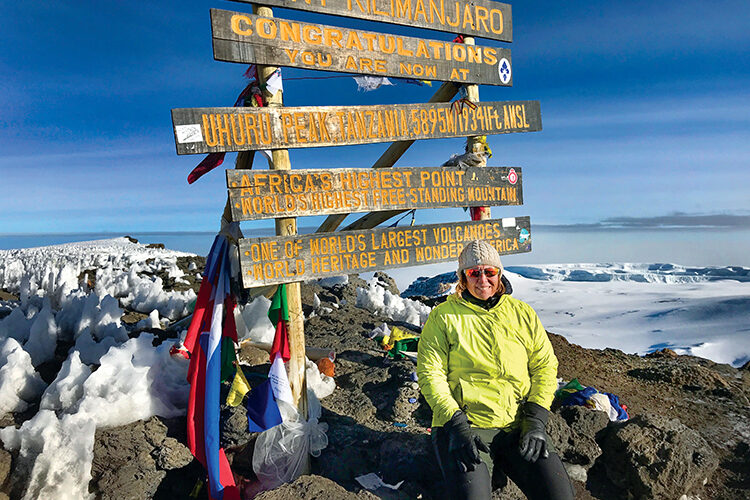Through freezing temperatures, sky-high altitudes, and physical exhaustion, avid hiker Sharon Feeney ’92 climbed 19,341 feet to the summit of Mt. Kilimanjaro in August 2018. Read about her milestone experience (and get some tips for your next hike).
Prepping for the Climb
Feeney is a habitual hiker, taking trips from her home in Morris Plains, N.J., to many national parks. But one barrier she hadn’t experienced, besides on a trip to Telluride: altitude. To prepare for Kilimanjaro, she searched for hikes that followed her guides’ recommendation for steepness and difficulty, to condition her body for what was to come in Tanzania. “I was probably, once I got into it, hiking 30 or 40 miles a week,” she says.
“I started with just hiking, then I put on a weight vest. The problem was, the vest is so evenly weighted, and it’s so comfortable, that you’re not getting your back used to what you have to [carry in a backpack]. So, after a while, I took the bricks out of it and put them in my backpack.
“After I got back [from Kilimanjaro], it was amazing how pleasurable it was to take the first few hikes with no backpack on. I thought, ‘Oh my God, this is so much more fun.’”
Up, Up, and Away
Feeney climbed the mountain with the guide service Ultimate Kilimanjaro, which she picked primarily due to its safety-first attitude. “They pretty much said, ‘Look, we’re not going to guarantee you getting up [to the top]. We’re going to guarantee, if you get up, you’ll be safe doing it.’
“It’s definitely not the kind of thing I would recommend unless you know what you’re getting into. I’ve heard it called a gentleman’s walk that virtually anybody can do. And while there’s some truth to that, the truth lies in the fact that it’s not a technical climb… there’s no ax climbing, there’s no icefall. But, it’s really, really high. There’s nothing even close to it in the U.S. to train on. So anybody who is going has to be prepared for the fact that they’re going to be spending days on a mountain where they essentially can’t breathe.”
What Are You Waiting For?
“I’ve always wanted to [hike Kilimanjaro]. Part of the block for me had always been that nobody else wanted to go. And I was just kind of like, ‘I’m 48 years old, what am I waiting for?’”
The Great Outdoors
As a psychologist, Feeney says being outdoors can help fight feelings of loneliness, especially during stay-at-home orders during the COVID-19 pandemic. “There’s something about the fresh air and not feeling cooped up that I think is really important for people.”
Want to start your own hiking adventure? Here are some of Feeney’s recommendations:
- She uses The Hiking Project, an app from the outdoors store REI, because of its good trail maps.
- “Yosemite is probably my favorite place on earth — I think there are 800 miles of hiking trails.”
- Looking for another big-time hike? Feeney followed the Haute Route in France and Switzerland, and she says that, while it was physically more challenging, the oxygenation was better than Kilimanjaro.
- Hydration packs, such as the Camelback, are key for hikes longer than 3 or 4 miles.
- Real hiking shoes are important, and boots aren’t ideal unless the terrain requires them, Feeney says. The real investment piece for your feet? High quality socks.

